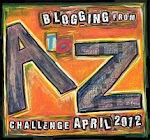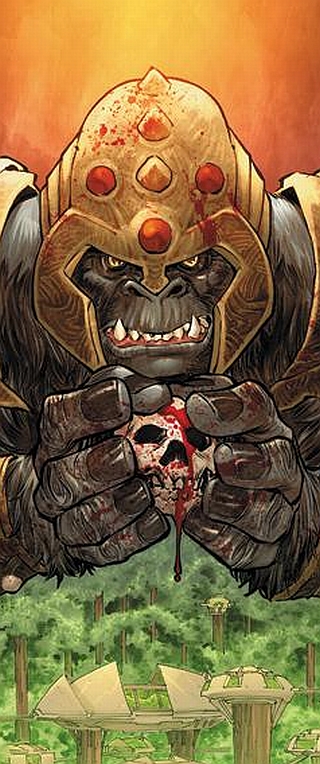
Sultan Nagendra rules a desert kingdom that controls several important oases and, therefore, controls the trade routes through the region as well. Things were not always so. Decades ago, Nagendra was a desert giant outcast, banished from his tribe because of his too enthusiastic worship of Apep, the Great Serpent. Bound, blindfolded, and weaponless, Nagendra’s people drove him to the Sun’s Anvil, the most terrible part of the desert. Everyone fully expected him to die therein of thirst.
Apep had other plans.
The Great Serpent transformed Nagendra into a terrifying creature of earth and dust and vengeance. When Nagendra emerged from the Sun’s Anvil, he brought with him a zealous tribe of desert giants, forged into a disciplined fighting force ready to enslave and conquer in Nagendra’s and Apep’s names. He first targeted his former tribe, killing or capturing the leaders. Those captured he fought in single combat over several days as a both a spectacle for his followers as well as a demonstration of his personal power. The sons of the leaders were also slain, but the wives and daughters were spared to become his wives. Nagendra then turned his sights on the oases communities, and he handily smashed the defenses of each in turn. Every time, his policy was the same: death to the leaders, but clemency to the people.
Design Notes: I’m skeptical that Nagendra is really CR 20, although that is what the numbers add up to based on base creature, templates, et cetera. He’s tough, but he doesn’t look like CR 20 tough. I really need to compare his relevant numbers to CR 20 baselines and tweak as necessary, but I’ve run out of time if I’m going to N posted before today runs out. Perhaps I’ll revisit Nagendra later.
Sultan Nagendra
Giant Earth-Infused Dust Creature Desert Giant Fighter 2/Serpent Archer 6
CR 20; XP 307,200
LE Huge outsider (air, augmented giant, earth, elemental, extraplanar)
Init +4; Senses low-light vision, tremorsense 20 ft.; Perception +14
DEFENSE
AC 35, touch 13, flat-footed 30 (+8 armor, +4 Dex, +1 dodge, +14 natural, -2 size); Mobility
hp 288 (21d10+168)
Fort +19, Ref +15, Will +8 (+9 against fear)
Defensive Abilities air mastery, bravery, rock catching; Immune elemental traits, fire
OFFENSE
Speed 50 ft., burrow 50 ft.
Melee Bastion or Lawbringer +25/+20/+15 (2d6+15/15-20), or
Melee Bastion and Lawbringer +23/+23/+18/+13 (2d6+10/15-20), or
Melee 2 slams +23 (2d6+10), or
Ranged Farbiter +22/+17/+12 (2d8+12/19-20, x3), or
Ranged Farbiter +20/+20/+14/+9 (2d8+12/19-20, x3), or
Ranged rock +19 (2d6+10), or
Ranged 2 rocks +17/+17 (2d6+10)
Space 15 ft.; Reach 15 ft.
Special Attacks exude dust, grounded, rock throwing (100 ft.), sand blast, scimitar training, serpent arrow
TACTICS
Nagendra’s forte is delivering a gob of damage whether in melee or at range.
* Bastion is a +3 defending scimitar. Nagendra typically boosts his AC by +2 when fighting with it. Lawbringer is a +1 axiomatic scimitar. It deals a bonus 2d6 points of damage against chaotic creatures. Nagrenda’s attack stats above do not include the modifiers for these weapons.
* Farbiter is a +2 distance composite longbow [Str +10]. It has a 220-foot range increment.
* Nagendra almost always exudes dust in combat. This surrounds him in a stationary 20-foot radius of blinding dust (see below).
* When full attacking but not using Rapid Shot, Nagendra uses Manyshot. This adds 2d8 for the additional arrow with his first shot.
* If Nagendra uses Deadly Aim with any ranged attack, apply a -4 attack roll penalty and add +8 damage for each missile.
* If he uses Improved Vital Strike with any single attack, roll the damage three times; then add Strength, et cetera, the extra damage for Devastating Strike. Here’s a breakdown: two-handed scimitar (2d6+21 plus 4d6), one-handed scimitar (2d6+16 plus 4d6), slam (2d6+16 plus 4d6), longbow (2d8+6 plus 4d8), or rock (2d6+16 plus 4d6). Nagendra uses Improved Vital Strike in combination with Shot on the Run.
* Nagendra is highly mobile. He uses his normal speed, burrowing, and airborne abilities to keep from being pinned down, maintain advantageous positioning, et cetera. Whenever Nagendra takes a move action, he relies on Improved Vital Strike and Devastating Strike to keep his damage output high.
STATISTICS
Str 31, Dex 18, Con 26, Int 12, Wis 14, Cha 13
Base Atk +17; CMB +29; CMD 44 (48 vs. disarm and sunder with scimitars)
Feats Combat Reflexes, Deadly Aim, Devastating Strike, Dodge, Great Fortitude, Improved Critical (longbow) (B), Improved Critical (scimitar), Improved Vital Strike (B), Iron Will (B), Mobility, Point Blank Shot, Rapid Shot, Shot on the Run (B), Two-Weapon Fighting, Vital Strike (B), Weapon Focus (longbow)
Skills Handle Animal +15 (+18 with snakes), Intimidate +32, Perception +14, Stealth +12, Survival +18; Racial Modifier +4 Stealth
Languages Auran, Common, Giant, Terran
SQ airborne, sandwalking, snake charmer, snake poison
SPECIAL ABILITIES
Air Mastery (Ex): Any airborne creature takes a –1 penalty on attack and damage rolls against Nagendra.
Airborne (Su): At will, Nagendra can walk on air as though with an air walk spell. In addition, he always falls as if affected by a feather fall spell. When falling, Nagendra can be moved on the wind as noted in the description of the air walk spell.
Burrow (Ex): Nagendra can burrow through rock at half speed, and he does not leave a tunnel behind when it burrows.
Craft Snake Salve (Su): Nagendra can concoct snake salve. He can make this magic item as if he met all of the prerequisites, and his caster level for creating this item is equal to his serpent archer class level. When under the influence of snake salve (or a magic fang spell), Nagendra’s snake arrow is treated as a weapon with the enhancement bonus the spell provides (so a snake-arrow with a +1 enhancement bonus to its bite from snake salve is treated as a +1 arrow).
Exude Dust (Su): At will as a free action, Nagendra can exude a cloud of dust that surrounds his body. This cloud functions like an obscuring mist spell, except all dust creatures can see through it normally. Any other creature caught within in the cloud must succeed on a DC 29 Reflex save or be blinded by the stinging dust. (The save DC is Constitution-based.) Success indicates that the creature closed or otherwise covered its eyes before the dust could affect them. The creature must keep its eyes closed or covered while within the dust cloud or risk blindness. A creature that enters the dust cloud with its eyes closed or covered need not make a save against blindness unless it opens its eyes while within the dust cloud. A creature blinded by Nagendra’s cloud of dust regains its sight 1d4 rounds after its last exposure to a dust cloud with its eyes open. Blinding exposure of even a single eye blinds all eyes supernaturally.
Grounded (Ex): While in contact with the earth, Nagendra gains a +1 morale bonus on attack and damage rolls for melee attacks.
Sand Blast (Su): At will as a standard action, a dust creature can emit an abrasive jet of dust-filled wind that damages objects and other creatures. This wind takes the form of a 5-foot-wide, 20-foot long line that causes 10d4 points of slashing damage. Any creature caught within the area may attempt a DC 29 Reflex save for half damage. The save DC is Constitution-based.
Sandwalking (Ex): A desert giant travels at full speed across sand, rocky ground, or dust, and leaves no trail behind unless it chooses to.
Scimitar Training (Ex): All desert giants are proficient with scimitars, and can wield them as if they were light weapons. A desert giant adds its full Strength bonus to attacks made with a scimitar wielded in its off hand, and gains a +4 bonus to CMD versus disarm and sunder attempts when fighting with a scimitar in each hand.
Serpent Arrow (Su): Nagendra may remove a Medium snake from a container (similar to drawing an arrow or bolt from a quiver) and pull its body straight and stiff, suitable for firing from a bow (longbow, shortbow, composite longbow, or composite shortbow) or crossbow (light or heavy). Nagendra can draw and straighten snakes as a free action up to 6 times per round; otherwise, doing so is a move-equivalent action. When fired from a bow in this manner, the snake deals normal damage for the bow. If the snake is a poisonous snake, it also injects the target with poison as if he had been bitten by the snake. After being fired in this manner, the snake is stunned for 1 round (normally falling to the ground at the feet of the target). Once the snake recovers, it continues to attack the target.
If not fired, a drawn snake relaxes from its stiffened state after one round.
Snake Charmer (Ex): Nagendra especially intuitive when dealing with normal snakes and thus receives a morale bonus on all Handle Animal checks when dealing with normal snakes equal to 1/2 his serpent archer level (minimum +1).
Snake Poison (Ex): Nagendra is familiar with handling snakes and dealing with snake venom. He never risks accidentally poisoning himself when handling snakes he has tamed.
GEAR
Bastion (+3 defending scimitar), Farbiter (+2 distance composite longbow [Str +10]), Lawbringer (+1 axiomatic scimitar), +5 studded leather, plus 65,000 gp of other gear selected from the royal armories and treasuries, depending on the situation. Nagendra almost always carries a sack full of Medium venomous snakes.
Tags: A to Z, NPCs, Pathfinder monsters




 Mystery obscures Lumusi’s origins. Through some ancient ritual, an entire rat swarm became awakened. This in itself wouldn’t necessarily be a problem, but Lumusi possesses an evil disposition and a desire to inflict loss on others. It lurks in the hidden places of urban areas and farming communities. From its lair, it stealths out under cover of night to wreak havoc. It uses its spells to charm animals and vermin (thanks to its Vermin Heart feat), damage crops and property, and cause sickness and death.
Mystery obscures Lumusi’s origins. Through some ancient ritual, an entire rat swarm became awakened. This in itself wouldn’t necessarily be a problem, but Lumusi possesses an evil disposition and a desire to inflict loss on others. It lurks in the hidden places of urban areas and farming communities. From its lair, it stealths out under cover of night to wreak havoc. It uses its spells to charm animals and vermin (thanks to its Vermin Heart feat), damage crops and property, and cause sickness and death.